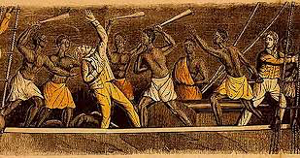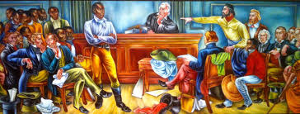The Amistad Decision: Victory for Those Enslaved
The acquittal of several dozen African slaves in 1839 was a landmark in the annals of American law. The 53 Africans (49 adults and four children) had been kidnapped from their homes in Sierra Leone in February 1839 by Portuguese slavers and sold into the Spanish slave trade. Two Spanish men, Don Pedro Montez and Don Jose Ruiz, eventually bought them in Havana, Cuba, and sent them aboard a ship north, to the United States. The ship was the Amistad, a Spanish word that means "friendship." The Amistad was not built to transport slaves, so the Spanish planters kept half of the Africans chained up in the main hold and the other half chained up on deck. 
Three days north of Havana, on July 1, the slaves revolted, freeing themselves of their shackles and killing the captain and most of the rest of the crew. The unshackled Africans, under the leadership of a man named Sengbe Pieh who was later known as Joseph Cinqué, then ordered their Spanish "owners" to set sail for Africa. Montez and Ruiz did indeed sail east, during the day; at night, however, they headed back west. This continues for more than two months. On August 24, the Amistad ran aground near Montauk Point, on Long Island, in the state of New York. U.S. forces claimed ownership of the ship and its property, which the Government interpreted to include the Africans. The ship was towed to New London, Conn., on August 29. The U.S. Government, after hearing what happened aboard the ship, charged the Africans with piracy and murder and sent them to a low-security prison in New Haven, Conn. The Spanish government, meanwhile, wanted Montez and Ruiz to return home, bringing their "property" with them. The Africans themselves asserted their claim that they were free, the victims of kidnapping in Africa, and should be let go, particularly since the slave trade was illegal in New York, where the Amistad had come ashore. Slavery within the United States was not prohibited by law, but bringing slaves into the country was. So how to define the Africans? Were they free men, wrongly taken from their homes? Were they guilty of rebellion and/or murder? The case took place against the backdrop of the burgeoning conflict between abolitionists and those who wanted to preserve the rights of slaveholders to keep hold of their "property." A Connecticut U.S. District Court judge agreed with the Africans and ordered an American ship to take them home. A U.S. Circuit judge agreed as well, and the U.S. Attorney appealed to the U.S. Supreme Court. 
Defending the Africans before the high court in United States v. Amistad was former President John Quincy Adams, then representing Massachusetts in the House of Representatives. Assisting Adams was Roger Sherman Baldwin. Attorney General Henry Gilpin put forth the U.S. Government's argument. The Supreme Court, under Associate Justice Joseph Story, on March 9, 1841, affirmed the lower courts' decisions, decreed that the Africans had never been slaves, had killed in self-defense, and were free to go. In the end, they did so, aboard the ship Gentleman. Only 35 made it home, however: the rest died at sea or in prison while they awaited their day in court. |
|
Social Studies for Kids
copyright 2002–2025
David White





